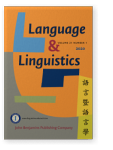Vol. 21:1 (2020) ► pp.33–53
The use of the Korean first person possessive pronoun nay vis-à-vis wuli
This paper takes a corpus-driven approach to the Korean first person possessive pronoun nay with reference to its plural counterpart wuli. The examination of the frequent noun collocates of the two pronouns in Sejong Corpus reveals the close connection between nay and inalienable entities as well as persons lower than the speaker. Meanwhile, wuli is strongly coupled with places or organizations alongside persons higher than the speaker. Pragmatic principles account for the difference between the kinship term collocates of the two pronouns, such as Horn’s (1984; 1989) R-principle or Levinson’s (2000) M-principle. The non-prototypical singular use of wuli triggers a pragmatic effect of expressing, for example, affection. The frequent collocation of nay with foreign/loan nouns is a reflection of the tendency that people more interested in social mobility (younger generation and women) are more ready to employ nay rather than the singular wuli and to accept foreign/loan words. The meaning of nay emerging from its interaction with noun collocates is that it is closely connected with being inalienable, private, or unshared. Meanwhile, the singular meaning of wuli is pragmatically derived, which is construed as being grouped, deferent, or general.
Article outline
- 1.Introduction
- 2.Background
- 2.1Possession and possessive constructions
- 2.2Possessive constructions and first person possessive pronouns in Korean
- 3.Data collection and methods
- 4.Analysis and discussion
- 4.1Top collocates of wuli and nay
- 4.2Abstract and concrete nouns
- 4.3Kinship terms and social relation nouns
- 4.4Body part nouns
- 4.5Place and organization (PO) nouns
- 5.Summary and conclusions
- Sources
- Acknowledgements
- Notes
- Abbreviations
-
References
For any use beyond this license, please contact the publisher at [email protected].
